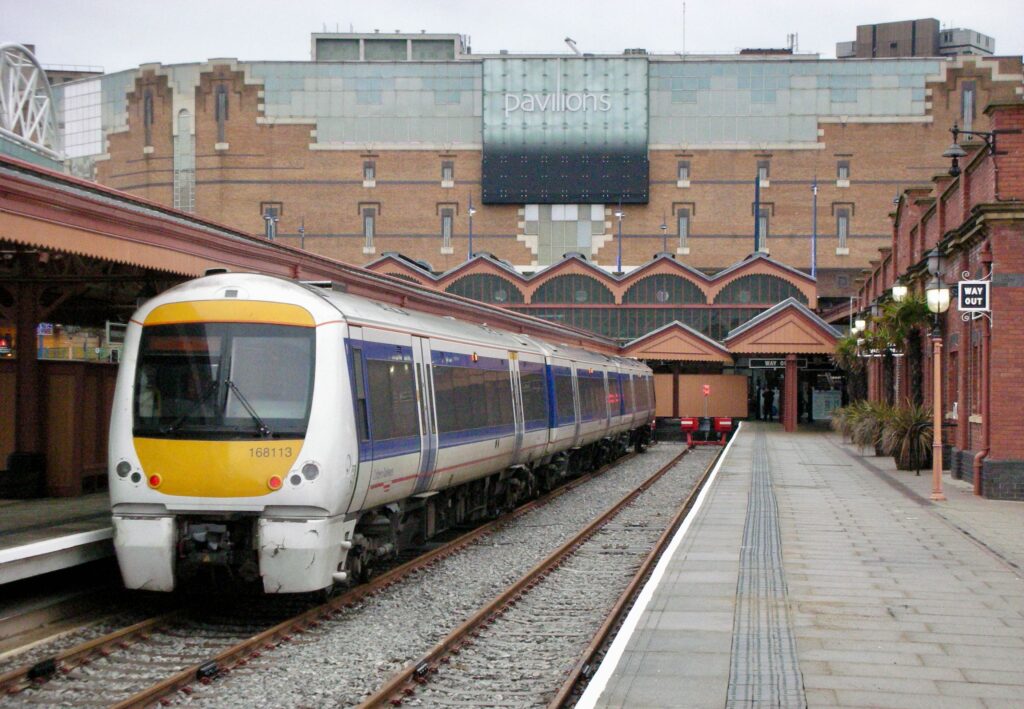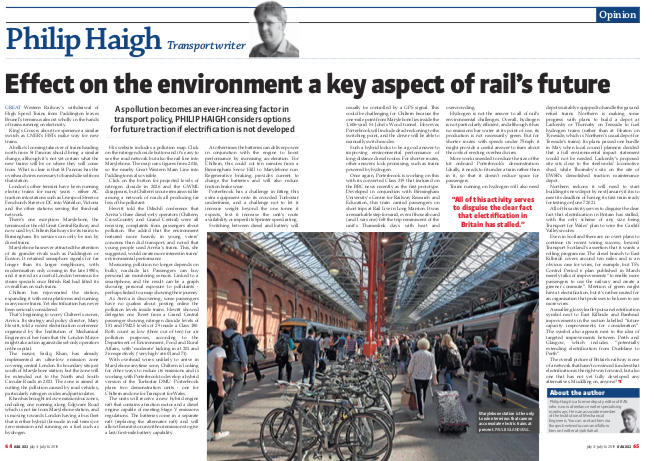Great Western Railway’s withdrawal of diesel High Speed Trains from Paddington leaves Brunel’s terminus almost wholly in the hands of electric trains.
King’s Cross is about to see a similar switch as LNER’s HSTs make way for new trains. Abellio’s looming takeover of trains heading north from St Pancras should bring a similar change. What is clear is that St Pancras has the overhead wires necessary to banish diesel from that station.
London’s other termini have been running electric trains for many years. There’s AC traction into stations such as Liverpool Street or Fenchurch Street. DC reigns into Waterloo, Victoria and the other stations serving the third-rail network.
There’s one exception. Marylebone, the terminus for the old Great Central Railway and now used by Chiltern Railways for its trains to Birmingham. It services can only be run by diesel trains.
Marylebone stands out
Marylebone has never attracted the attention of its grander rivals such as Paddington or Euston. It kept semaphore signals for far longer than its larger neighbours. Modernisation only came in the late 1980s which made it a useful London terminus for steam specials.
Chiltern has rejuvenated the station, expanding it with extra platforms and running many more trains. Yet electrification has never been seriously considered.
That’s beginning to worry Chiltern’s owner, Arriva. Strategy and Policy Director Mary Hewitt addressed a recent electrification conference organised by the Institution of Mechanical Engineers. She spoke of her fears that the London Mayor might take action against diesel-only operators in the capital.
The mayor, Sadiq Khan, has already implemented an ultra-low emission zone covering Central London. Its boundary sits just south of Marylebone station but the zone will be extended out to the North and South Circular Roads in 2021. The zone is aimed at cutting the pollution caused by road vehicles, particularly nitrogen oxides and particulates.
Khan brought in low-emission bus zones, including one on Edgware Road, which is not far from Marylebone station. He is moving towards a London bus fleet that of hybrid or zero-emission vehicles.
His website includes a pollution map. Click on the nitrogen dioxide button and it’s easy to see the road network and the rail line into Marylebone. The map uses figures from 2016 so the nearby Great Western Main Line into Paddington is also visible.
Click on the button for projected levels of nitrogen dioxide in 2026 and the GWML disappears. However, Chiltern’s route remains among a network of roads all producing far less of the pollutant.
Diesel trains bring pollution complaints
Hewitt told the conference that Arriva’s three diesel-only operators (Chiltern, CrossCountry and Grand Central) were all receiving complaints about pollution from passengers. She added that the environment featured more heavily in young voters’ concerns than did transport and noted that young people used Arriva’s trains. This, she suggested, would create more interest in trains’ environmental performance.
Measuring pollution no longer depends on bulky roadside kit. Passengers can buy personal air monitoring sensors. If linked to a smartphone, they can produce a graph showing personal exposure to pollutants. It can be linked to a map showing their journey.
As Arriva is discovering, some passengers have no qualms about posting online the pollution levels inside trains. Hewitt revealed to delegates a Tweet from a Grand Central passenger. It showed nitrogen dioxide levels of 151 and PM2.5 levels of 29 inside a Class 180. Both are low (three out of 10) for air pollution purposes, says the Department of Environment, Food and Rural Affairs. ‘Moderate’ kicks in at 201 and 36 respectively (‘very high’ at 601 and 71).
With overhead wires unlikely to arrive in Marylebone anytime soon, Chiltern is looking for other ways to reduce its emissions. It’s working with Porterbrook to develop a hybrid version of the Turbostar DMU. Porterbrook plans two demonstration units with one for Chiltern and one for Transport for Wales.

Upgrading a diesel Turbostar
The units will contain a new hybrid engine raft with a traction motor and a diesel engine capable of meeting Stage V emission regulations.
The batteries come in a separate raft that replaces the alternator raft. They will allow the units to run without emissions to give a last/first-mile battery capability. At other times the batteries can deliver power in conjunction with the engine to boost performance by increasing acceleration. For Chiltern, this could cut 10 mins from a Birmingham Snow Hill to Marylebone run. Regenerative braking provides current to charge the batteries and will also reduce friction brake wear.
Porterbrook has a challenge in fitting this extra equipment onto its crowded Turbostar underframe. A second challenge is to prevent its weight increases beyond the one tonne it expects. This would increase the unit’s route availability or imperil its Sprinter speed rating.
Switching between diesel and battery will usually be controlled by a GPS signal. This could be challenging for Chiltern because the one-mile point from Marylebone lies inside the 1,606-yard St John’s Wood tunnel. However, Porterbrook will include dead-reckoning to the switching point and the driver will be able to manually switch modes.
Create a hydrogen train
Such a hybrid looks to be a good answer to improving environmental performance of long-distance diesel routes. For shorter routes, other answers look promising such as trains powered by hydrogen. Once again, Porterbrook is working on this with a converted Class 319. Developed with Birmingham University’s Centre for Railway Research and Education, this train carried passengers on short trips at RailLive in Long Marston.
Hydrogen is not the answer to all of rail’s environmental challenges. It is not particularly efficient and although it has no emissions bar water at its point of use, producing it is not necessarily green.
For shorter routes with speeds under 75mph, it might be suitable and remove fears about the costs of overhead wires.
There’s more work needed to reduce the size of the kit onboard Porterbrook’s demonstration. Ideally, it needs to fit under a train rather than in it so that it doesn’t reduce space for passengers. Trains running on hydrogen will need depots suitable equipped to handle the gas and refuel trains.
Northern is planning a depot at Lackenby or Thornaby on Teesside to fuel hydrogen trains. (Rather than at Heaton on Tyneside which is Northern’s usual depot for Teesside’s trains). The plans passed one hurdle in May when local council planners decided that they did not need a full environmental impact statement. Lackenby’s proposed site sits close the the steelworks’ locomotive shed. Thornaby sits on the site of EWSR’s demolished traction maintenance depot.
Northern reckons it will need to start building by next January to have a train for testing by its June 2021 deadline.
Electrification has stalled
All of this activity serves to disguise the clear fact that electrification in Britain has stalled. The only scheme of any size is Transport for Wales’ plan to wire the Cardiff Valleys routes. Even in Scotland there are no overt plans beyond Transport Scotland’s assertion that it wants a rolling programme. The diesel branch to East Kilbride covers around 10 miles and is an obvious case for wires. However, TS’s Control Period 6 plan merely talks of improvements “to enable more passengers to use the railway and create a greener commute”.
Mention of green hints at electrification but it’s muted for an organisation that says it’s keen to see more wires.
The overall picture of Britain’s railway is one that has neither convinced funders about electrification nor fully developed any alternatives. Muddling on, anyone?
This article first appeared in RAIL 881, published on July 3 2019.
